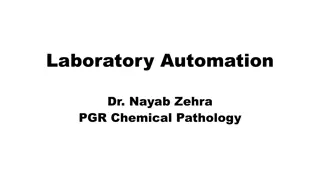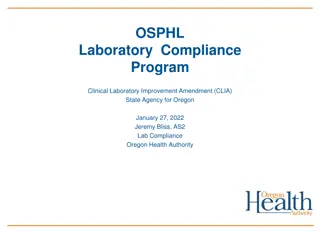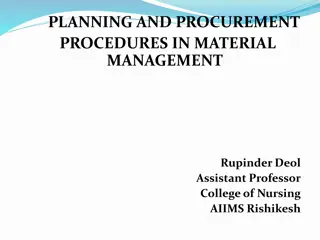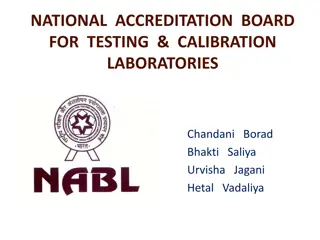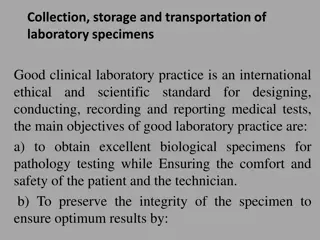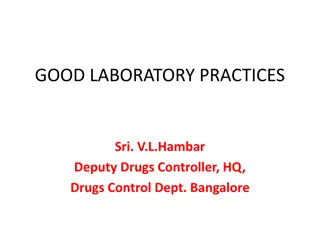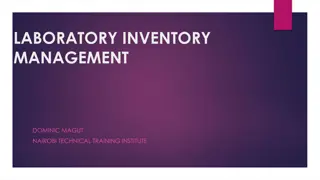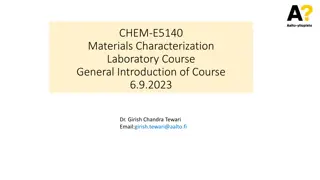Laboratory Material Management: Ensuring Quality and Efficiency
Effective inventory and quality management are crucial in laboratories to maintain workflow efficiency and prevent errors. Monitoring the quality of inventory flow, ensuring sufficient supplies, and procuring quality materials are key factors in maintaining a high standard of laboratory services. Quality controls and proper procurement procedures play a vital role in providing accurate diagnostic test results. Understanding the utility and feasibility of new tests, considering clinical needs and cost-effectiveness, is essential for operational success.
Download Presentation

Please find below an Image/Link to download the presentation.
The content on the website is provided AS IS for your information and personal use only. It may not be sold, licensed, or shared on other websites without obtaining consent from the author. Download presentation by click this link. If you encounter any issues during the download, it is possible that the publisher has removed the file from their server.
E N D
Presentation Transcript
Quality System Essential: Inventory Management Quality Management of Laboratory Material ISO 15189: 2012 9/10/2024 Labs for Life Project - India 1
Inventory management Quantity Management Ensuring the quantity of supplies as required so as ensure smooth workflow Serves to prevent stock outs and maintain turnaround times (TAT) 9/10/2024 Labs for Life Project - India 2
Quality management WHY ? Reliable monitoring the quality of its inventory flow Ensuring quality of material is an integral part of quality assurance in the laboratory The primary error prevention step: Quality Reagents diagnostic services require 9/10/2024 Labs for Life Project - India 3
Quality Controls (IQC/EQA) used for monitoring of the precision/accuracy of analytical system, are dependent on supply of quality reagents Checking the quality of reagents and consumables before procuring/using them Important interfering variable in the final patient report 9/10/2024 Labs for Life Project - India 4
Quality Management HOW ? Selection and procurement of diagnostic laboratory materials is challenging given the Wide choice of products and suppliers Procurement policies prevalent in the system A series of steps must be followed to ensure the quality of materials used in the laboratory 9/10/2024 Labs for Life Project - India 5
Quality Management Introducing a new method/ Retendering for an existing test For tests already in use 9/10/2024 Labs for Life Project - India 6
Understanding Utility and Feasibility 9/10/2024 Labs for Life Project - India 7
Understanding requirements for the NEW test: Initial thoughts Clinical utility Understand the needs of patients and users Understand the performance of a test Feasibility Test demand Cost effectiveness Operationalizing 9/10/2024 Labs for Life Project - India 8
Clinical utility (Need and Performance) Discovery of novel biomarkers e.g. Lp(a), homocysteine Change in disease trends e.g. Swine flu Recent advances in assay methods e.g. Immunoassay, quantitative Trop I Different testing objectives e.g. screening, confirmatory, treatment monitoring, surveillance etc Relevance: diagnostic sensitivity & specificity, positive & negative predictive values (Literature, guidelines, pilot studies) 9/10/2024 Labs for Life Project - India 9
Feasibility Cost inputs Reagents Quality controls Proficiency testing Calibrators Equipment Cost cutting Improved TAT Better performance Improved safety 9/10/2024 Labs for Life Project - India 10
Survey the market for products 9/10/2024 Labs for Life Project - India 11
Market survey Researching the available test options by interacting with the vendors Different product kit inserts should be consulted to understand the differences in performance characteristics of the various kits 9/10/2024 Labs for Life Project - India 12
Understand Operationalizing Requirements 9/10/2024 Labs for Life Project - India 13
Challenges in Operationalizing Test complexity Compatibility with current equipment/ infrastructure/LIS Staffing/training requirements Space/ Open system/ Closed system IQC/EQA requirements/ availability Type and quantity of sample required Patient/sample preparation required Pre-analytical acceptance criteria and possible errors Sample storage criteria 9/10/2024 Labs for Life Project - India 14
Initial thoughts.. Gathering Evidence Ensuring quality of the manufacturing process 9/10/2024 Labs for Life Project - India 15
Ensuring quality of the manufacturing process The specification may request products that have been approved by national and international regulatory agencies e.g. FDA, CE, WHO etc. 9/10/2024 Labs for Life Project - India 16
Understanding Performance Specifications stated by manufacturers 9/10/2024 Labs for Life Project - India 17
Quality requirements, Fitness for Purpose All laboratory measurements carry some uncertainty/error Different testing objectives e.g. screening, confirmatory, treatment monitoring, surveillance etc. Lab must decide the level of error which could be acceptable/ allowable: Quality Specifications 9/10/2024 Labs for Life Project - India 18
Quality requirements/ Specifications, Fitness for Purpose Precision (Dispersion of results in repeated examinations) Bias (Accuracy/ Comparability) Linearity (AMR) Analytical sensitivity, LoB, LoD, LoQ Analytical Specificity, interferences Biological Reference Interval (BRI) 9/10/2024 Labs for Life Project - India 19
Which reagents? For all reagents: Sensitivity, Specificity Tests with numerical results: Deliberation on Precision, Accuracy, Linearity, BRI 9/10/2024 Labs for Life Project - India 20
Precision The agreement of the measurements of replicate runs of the same sample. It may be understood as the dispersion of repeated measurements about the mean value. Precision is measured in terms of coefficient of variation (CV). Most reagent manufacturers specify repeatability (intra-assay/within-run precision) intermediate (inter-assay/between-run) precision. This also will be specified for different clinical decision levels. 9/10/2024 Labs for Life Project - India 21
An example. The following data was obtained using the Glucose Reagent on XYZ analyzers according to established procedures. Results obtained in individual laboratories may differ. The within run precision for serum samples is less than 3%CV and total precision is less than 3%CV =100 Within run Total Mean, mg/dl SD CV% SD CV% 59.1 0.4 0.7 0.9 1.6 258.1 1 0.4 3.8 1.5 9/10/2024 Labs for Life Project - India 22
Accuracy Comparability: Accuracy or trueness is the degree of closeness of measured values (using a given method) to the true/correct value and comparability of the method to the reference method Bias is a quantitative measure of the average difference between results from a given measurement procedure and results from an accepted reference measurement procedure. 9/10/2024 Labs for Life Project - India 23
9/10/2024 Labs for Life Project - India 24
How is accuracy denoted on a kit insert? Method comparison in the kit insert. Data from Regression analysis (Correlation Coefficient, Slope, and Intercept) Data from Difference Calculations 9/10/2024 Labs for Life Project - India 25
Data from Regression analysis (Correlation Coefficient, Slope, and Intercept) The correlation coefficient denotes the comparability and should be > 0.975%. The ideal is 1. The slope and the intercept denote the bias from the reference methods. The number of samples compared and the measurement range covered for comparison studies are also given. 9/10/2024 Labs for Life Project - India 26
Method Comparison (Serum) Patient samples were used to compare this Glucose Reagent with a reference reagent. The table below demonstrates representative performance on XYZ analyzers. Y Method XYZ1 X Method XYZ2 Slope 0.986 Intercept 0.4 1.000 Correlation Coefficient (r) No. of Samples (n) 180 Range (mg/dL) 10-644 9/10/2024 Labs for Life Project - India 27
Data from Difference Calculations 9/10/2024 Labs for Life Project - India 28
Linearity Analytical measurement range (AMR): Linearity is the range of analyte values that a method can directly measure on the specimen without any dilution, concentration, or other pretreatment not part of the usual assay process. It indicates the consistency of imprecision and accuracy (bias) over the range of measurement. A higher range gives better advantage in analysis 9/10/2024 Labs for Life Project - India 29
An Example The Glucose procedure is linear from 10 - 800 mg/dL for serum and cerebrospinal fluid determinations; 10 - 700 mg/dL for urine determinations. Samples exceeding the upper limit of linearity should be diluted and repeated. The sample may be diluted, repeated and multiplied by the dilution factor automatically by utilizing the AUTO REPEAT RUN. 9/10/2024 Labs for Life Project - India 30
Analytical Sensitivity It is defined as the lowest concentration of an analyte/ substance that can be distinguished from background noise. Limit of Blank (LoB) Limit of Detection (LoD) Limit of Quantitation 9/10/2024 Labs for Life Project - India 31
Analytical Specificity It is the ability of an assay procedure to determine the concentration of a target analyte without influence from other (potentially interfering) substances or factors in the sample matrix. Includes: cross reactivity Interference Endogenous Exogenous 9/10/2024 Labs for Life Project - India 32
Cross reactivity Cross Reactivity: refers to the erroneous recognition of antigenically similar substances e.g. genetically related microorganisms, cross reacting antibodies/ antigens, etc 9/10/2024 Labs for Life Project - India 33
Interference Interference is an artefactual increase or decrease in the apparent quantity of an analyte due to the presence of a substance that reacts nonspecifically with the measuring system. Endogenous interferences include hemolysis (hemoglobin), icterus (bilirubin), lipemia, medications, binding proteins Exogenous interferences are caused by the introduction of external factors or conditions not normally present in native, properly collected and stored samples e.g. blood collection tube additives, serum separators. 9/10/2024 Labs for Life Project - India 34
Sensitivity Specificity an example.. 9/10/2024 Labs for Life Project - India 35
Specificity, an example.. 9/10/2024 Labs for Life Project - India 36
Biological Reference Intervals When measurement of an analyte is performed in a group of well-defined reference individuals, the central 95% interval of results obtained is referred to as the Biological Reference Interval for that analyte. It is frequently provided as the interpretive information along with laboratory test results. It may vary for different demographic samples according to genetic and environmental factors. 9/10/2024 Labs for Life Project - India 37
Deciding on which reagent to purchase Quality requirements, Fitness for Purpose Comparing the Stated Claims against Acceptable Error Specifications 9/10/2024 Labs for Life Project - India 38
Acceptable error where to look ? Published literature documented quality specifications for the test e.g. BV database Guidelines by international/national experts/ groups Regulations e.g. CLIA EQA/PT schemes: acceptable error based provided data Professional judgment They recommend participant on 9/10/2024 Labs for Life Project - India 39
Milan Mandate 2015 Gives a hierarchy of sources to set performance goals a) Goals based on analytical performance related to Clinical Outcomes b) Goals based on Biological Variation c) Goals based on everything else e.g. Expert group opinions/ guidelines, EQA/PT goals 9/10/2024 Labs for Life Project - India 40
Some resources (online databases) Biological Variation database CLIA requirements for analytical quality RCPA (Royal College of Pathologists of Australasia) French/Belgian EQA performance specifications European biologic goals RiliBAK (Guidelines of the German Federal Medical Council) 9/10/2024 Labs for Life Project - India 41
Comparing Manufacturers statements Manufacturer A Manufacturer B 9/10/2024 Labs for Life Project - India 42
Comparing Manufacturers statements 9/10/2024 Labs for Life Project - India 43
UNDERSTANDING QUALITY REQUIREMENTS Desirable Biological Variation Database specifications CVI= within-subject biologic variation CVG= between-subject biologic variation I = desirable specification for imprecision B = desirable specification for inaccuracy TE = desirable specification for allowable total error 9/10/2024 Labs for Life Project - India 44
UNDERSTANDING QUALITY REQUIREMENTS PUBLISHED SOURCES LoQ of different TSH assay methods Functional sensitivity (LoQ) 1.0-2.0 U/L Inter-assay CV TSH assay 1st generation <20% 2nd generation <20% 0.1-0.2 U/L 3rd generation <20% 0.01-0.02 U/L 4th generation <20% 0.001-0.002 U/L 9/10/2024 Labs for Life Project - India 45
Develop Checklists, assess Bran d FDA /CE/ Other approvals Precision Accuracy Linear ity Sensiti vity Specific ity Scor e MD P 1 MDP 2 r Slope Inte %Bia s rcep t X Y Z 9/10/2024 Labs for Life Project - India 46
Understanding how to include Commercial aspects 9/10/2024 Labs for Life Project - India 47
Extras that you can include into the process: Post-purchase verification process Quality assurance through acceptance testing Application support Complaint resolution mechanisms Review of agreement Supplier track record evaluation 9/10/2024 Labs for Life Project - India 48
Writing Technical Specifications Correctly, to your advantage Writing Technical Specifications thus includes: 1. Quality Specifications 2. Operational Specifications 3. Commercial Specifications 9/10/2024 Labs for Life Project - India 49
Two bid systems The procurement of reagents and consumables generally follows a two-bid system where tenders are invited in two parts Technical Bid Price/ Financial Bid 9/10/2024 Labs for Life Project - India 50










